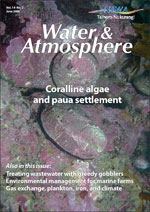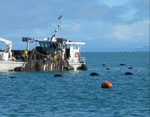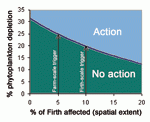PDF of this article (174 KB)


John Zeldis, Malene Felsing, and John Wilson explain how a novel management framework has been implemented to protect the environment as well as the interests of many stakeholders in the aquaculture industry.
Sustainable management of marine farming requires certainty for industry investment, while maintaining the health and integrity of coastal ecosystems.
- Can we agree on rules governing environmental effects?
- If the rules are breached, how can the regional council responsible for managing the health of the local coastal ecosystem respond?
- When formulating the rules, how can we accommodate uncertainty in the science about effects of aquaculture on ecosystems?
When asked by Environment Waikato (EW) to help answer these questions, NIWA suggested 'limits of acceptable change' (LAC). This management framework has been applied to topics ranging from tourism in US national parks to disposal of dredge spoil on the Great Barrier Reef, but had never before been tried with aquaculture. LAC is not a tool for determining resource usage levels that are ecologically sustainable or that maintain a certain carrying capacity, but provides an adaptive management framework to prevent significant adverse environmental effects during resource use.
As a result of NIWA’s suggestion, EW has implemented a 'trigger point' framework for aquaculture management for the Wilson Bay Marine Farm Zone in the Firth of Thames. This Aquaculture Management Area (AMA), with a total area of over 3000 ha, harbours the largest block of marine farms in New Zealand. EW’s Regional Coastal Plan stipulates that the marine farming zone should be developed in stages to ensure that farming activities do not cause significant adverse effects.
In ecological terms, it can be hard to determine what constitutes 'adverse' and ’significant', and the LAC approach acknowledges the difficulty in defining levels of acceptable ecological change. Nonetheless, it still demands that acceptable degrees of change be agreed upon. The approach provides a collaborative framework for identifying environmental indicators of change, setting levels of acceptable change in the indicators, and identifying management responses when the levels are exceeded.
Stakeholder participation at Wilson Bay

The use of LAC is well illustrated by our experience at Wilson Bay. There were initial meetings of EW, Auckland Regional Council, Environment Bay of Plenty, marine farmers at Wilson Bay, and scientists from the Cawthron Institute and NIWA. Based on the best scientific advice available for the Firth of Thames ecosystem, NIWA made recommendations for acceptable levels of phytoplankton depletion and benthic impacts, which were peer-reviewed by the Cawthron Institute.
NIWA’s scientific advice was based on our extensive ecosystem research in the Firth and Hauraki Gulf. This work showed that natural changes from year to year in phytoplankton levels in the Firth cause large changes in zooplankton population levels, which, in turn, cause large changes in numbers of larval fish. Phytoplankton is an important fundamental resource, so NIWA proposed that some control over its use by mussel farming was desirable to ensure sustainability of both the mussel farms and the environment. The LAC measure recommended was that phytoplankton removal by the development at Wilson Bay should not exceed 20% over 10% or more of the Firth. This addressed Council requirements that effects be considered with respect to the total Firth ecosystem, and limits phytoplankton reduction to levels well below those known to cause large effects higher in the food web. The meeting participants considered all information available to arrive at acceptable limits of depletion resulting from marine farm development and agreed to the 20 trigger point.
We also saw the need for a more local trigger level that considered effects in the immediate farm vicinity. This recognises that, while effects were ultimately to be considered with respect to the whole Firth ecosystem, they were actually measured in the immediate vicinity of the farms, primarily by the water-quality monitoring programme stipulated by the resource consents. This farm-scale trigger level states that phytoplankton reduction should not exceed 25%, in an area twice the size of the AMA, compared to levels before the farm was stocked. At NIWA we are using extensive biophysical modelling to translate the farm-scale measurements to the Firth-wide trigger point.
The graph shows the relationships of the farm- and Firth-scale trigger levels. The framework has been formalised within environmental management of the Wilson Bay development, and includes a clear step-by-step set of management responses should the farm-scale trigger level be exceeded. Responses range from convening a meeting to consider the evidence further, to commissioning further investigations, to reviewing consent conditions.
LAC rules must be based on ecological indicators that are environmentally significant and are practical to measure. To manage potential effects on the seabed, trigger levels for various indicators of animal abundance and sediment characteristics have also been established in consultation with stakeholders.
Adaptability and transparency
An important point is that LAC indicators and associated trigger levels are subject to modification should improved scientific information become available. This is where information on sustainability or carrying capacity, obtained through ecosystem research, can be added. The LAC framework therefore allows for adaptive management in a number of different ways and time scales.
Finally, the LAC process is transparent. In the Wilson Bay case, industry, environmental managers, and scientists all took part in discussions and agreed to the proposed trigger points and the anticipated management responses. Indicators for environmental performance and associated trigger levels are agreed in advance of development, and management responses should these trigger levels be exceeded are clearly delineated. It thus provides certainty for stakeholders, all of whom value the natural resources involved in the marine farming industry.
This is the first time the LAC framework has been implemented in the context of aquaculture, and it is a great first step for aquaculture management in the Wilson Bay AMA. To ensure its continued relevance, EW regularly reviews the variables monitored and the trigger points. Our experience with LAC provides a valuable reference for management of large-scale aquaculture elsewhere in New Zealand, and internationally.
Setting limits
- One of the strengths of LAC is collaboration among all interested parties (stakeholders).
- 'Trigger points' that determine when limits have been reached can be reviewed and modified as we learn more about environmental effects.
- The trigger points alert managers to various actions, which range from meeting with other stakeholders to reviewing resource consents.
Further reading
Cole, D.N.; Stankey, G.H. (1998). Historical development of Limits of Acceptable Change: conceptual clarifications and possible extensions. Proceedings – Limits of Acceptable Change and related planning processes: Progress and future directions, Missoula, Montana. General Technical Report INT-GTR-371.
Oliver, J.K. (1995). Is the 'limits of acceptable change' concept useful for environmental managers? A case study from the Great Barrier Reef Marine Park. In: Grigg, G.C.; Hale, P.T.; Lunney, D. (eds), Conservation through sustainable use of wildlife, pp. 131-139. Centre for Conservation Biology, University of Queensland, Brisbane.
Stankey, G.H.; Cole D.N.; Lucas, R.C.; Petersen, M.E.; Frissell, S.S. (1985). The limits of acceptable change (LAC) system for wilderness planning. US Department of Agriculture Forest Service General Technical Report INT-176. 37 p.
Stenton-Dozey, J.; Zeldis, J.; Vopel, K. (2005). Mussel farming in Wilson Bay, Firth of Thames – a public document. NIWA report for Wilson Bay Group A Consortium; contact John Wilson at [email protected]
Turner, S.; Felsing, M. (2005). Trigger points for Wilson’s Bay Marine Farming Zone. Environment Waikato Technical Report 2005/28.
Zeldis, J.; Oldman. J.; Ballara S.; Richards, L. (2005). Physical fluxes, pelagic ecosystem structure, and larval fish survival in Hauraki Gulf, New Zealand. Canadian Journal of Fisheries and Aquatic Sciences 62: 593-610.
Dr John Zeldis is a biologist who works at NIWA in Christchurch on marine ecosystems and aquaculture. Dr Malene Felsing is a coastal ecologist with Environment Waikato, and John Wilson, of John Wilson Consulting Ltd, is a consultant to the marine farming industry.
Teachers’ resource for NCEA AS: Biology 90483 (2.9) Science 90187 (1.2), 90771 (2.2). See other curriculum connections at www.niwa.co.nz/pubs/wa/resources
